FREE CLEP College Math Practice Test
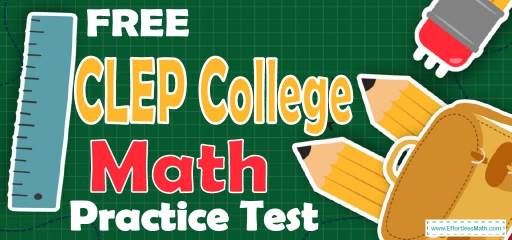
Welcome to our FREE CLEP College Math practice test, with answer key and answer explanations. This practice test’s realistic format and high-quality practice questions can help you succeed on the CLEP College Math test. Not only does the test closely match what you will see on the real CLEP College , but it also comes with detailed answer explanations.
For this practice test, we’ve selected 20 real questions from past exams for your CLEP College Practice test. You will have the chance to try out the most common CLEP College Math questions. For every question, there is an in-depth explanation of how to solve the question and how to avoid mistakes next time.
Use our free CLEP College Math practice tests and study resources (updated for 2021) to ace the CLEP College Math test! Make sure to follow some of the related links at the bottom of this post to get a better idea of what kind of mathematics questions you need to practice.
The Absolute Best Book to Ace the CLEP College Math Test
10 Sample CLEP College Math Practice Questions
1- If \(2x+2y=2, 3x-y=7\), which of the following ordered pairs \((x,y)\) satisfies both equations?
A. \((1,3)\)
B. \((2,4)\)
C. \((2,-1)\)
D. \((4,-6)\)
2- If \(f(x)=3x+4(x+1)+2\) then \(f(4x)=\)?
A. \( 28x+6\)
B. \( 16x-6\)
C. \( 25x+4\)
D. \( 12x+3\)
3- A line in the \(xy\)-plane passes through origin and has a slope of \(\frac{1}{3}\). Which of the following points lies on the line?
A. \((2,1)\)
B. \((4,1)\)
C. \((9,3)\)
D. \((6,3)\)
4- Which of the following is equivalent to \(3?^2+2?+6−2?^2−4\)?
A. \( n+4n^2\)
B. \( n^2-3\)
C. \( n^2+2n+10\)
D. \( n+2\)
5- Solve for \(x: 4(x+1)=6(x-4)+20\)
A. 12
B. 6.5
C. 4
D. 2
6- If \(?≠−4\) and \(?≠5\), which of the following is equivalent to \(\frac{1}{\frac{1}{?−5}+\frac{1}{?+4}}\)?
A. \(\frac{(x-5)(x+4)}{(x-5)+(x+4)}\)
B. \(\frac{(x+4)+(x-5)}{(x+4)(x-5)}\)
C. \(\frac{(x+4)(x-5)}{(x+4)-(x+5)}\)
D. \(\frac{(x+4)+(x-5)}{(x+4)-(x-5)}\)
7- \(y < c-x , y > x+b\)
In the \(xy\)-plane, consider (0,0) is a solution to the system of inequalities above, which of the following relationships between c and b must be true?
A. \( c < b\)
B. \( c>b\)
C. \( c=b\)
D. \(c= b+ c\)
8- What is the value of \(x\) in the following equation? \(3x+10=46\)
A. 4
B. 7
C. 10
D. 12
9- Calculate \(?(5)\) for the following function \(?\).
\(?(?)=?^2−3?\)
A. 5
B. 10
C. 15
D. 20
10- John buys a pepper plant that is 5 inches tall. With regular watering the plant grows 3 inches a year. Writing John’s plant’s height as a function of time, what does the ?−intercept represent?
A. The y-intercept represents the rate of grows of the plant which is 5 inches
B. The y-intercept represents the starting height of 5 inches
C. The y-intercept represents the rate of growth of plant which is 3 inches per year
D. There is no y-intercept
11- If \(\frac{4}{x}=\frac{12}{x-8}\) what is the value of \(\frac{x}{2}\)?
A. 1
B. 3
C. \(-2\)
D. 2
12- If the following equations are true, what is the value of \(x\)? \((a=\sqrt{3}), (4a=\sqrt{4x})\)
A. 2
B. 3
C. 6
D. 12
13- In the triangle below, if the measure of angle A is \(37\) degrees, then what is the value of \(y\)? (figure is NOT drawn to scale)
\(\img{https://appmanager.effortlessmath.com/public/images/questions/jjjjuuuu.png
}\)
A. 70
B. 78
C. 84
D. 86
14- The circle graph below shows all Mr. Green’s expenses for last month. If he spent $660 on his car, how much did he spend for his rent?
\(\img{https://appmanager.effortlessmath.com/public/images/questions/66lll.png
}\)
A. $700
B. $740
C. $810
D. $910
15- The Jackson Library is ordering some bookshelves. If \(x\) is the number of bookshelves the library wants to order, which each costs $200 and there is a one-time delivery charge of $600, which of the following represents the total cost, in dollar, per bookshelf?
A. \( \frac{200x+600}{x}\)
B. \( \frac{200x+600}{200}\)
C. \( 200+600x\)
D. \( 200x+600\)
16- A function \(g(3)=5\) and \(g(5)=4\). A function \(f(5)=2\) and \(f(4)=6\). What is the value of \(f(g(5))\)?
A. 5
B. 6
C. 7
D. 8
17- What is the area of the following equilateral triangle if the side ??=12 cm?
\(\img{https://appmanager.effortlessmath.com/public/images/questions/ttt.png
}\)
A. \( 36\sqrt{3}\) cm\(^2\)
B. \( 18\sqrt{3}\) cm\(^2\)
C. \( 6\sqrt{3}\) cm\(^2\)
D. 8 cm\(^2\)
18- If \(x∎y=\sqrt{x^2+y}\), what is the value of \(6∎28\)?
A. \(\sqrt{168}\)
B. 10
C. 8
D. 6
19- If \(A={1,2,4,8,16,24}\) and \(B={1,4,12,24,32,48}\), how many elements are in \(A∪B\)?
A. 2
B. 3
C. 6
D. 9
20- What is the value of \(y\) in the following system of equation?
\(3x-4y= -20\)
\(-x+2y= 10\)
A. \(-1\)
B. \(-2\)
C. 1
D. 5
Best CLEP College Math Prep Resource for 2021
Answers:
1- C
Plugin the values of \(x\) and \(y\) provided in the choices into both equations. Let’s start with \(2x+2y=2\):
A.\((1,3) : 2x+2y=2→2+6≠2\)
B.\((2,4): 2x+y=2→4+8≠2\)
C.\((2,-1) :2x+2y=2→4+(-2)=2\)
D.\((4,-6): 2x+2y=2→12+(-12)≠2\)
E.\((1,-6): 2x+2y=2→2+(-12)≠2\)
Only choice C is correct.
2- A
If \(f(x)=3x+4(x+1)+2\), then find \(f(4x)\) by substituting \(4x\) for every \(x\) in the function. This gives: \(f(4x)=3 (4x)+ 4(4x+1)+2\)
It simplifies to: \(f(4x)=3 (4x)+4(4x+1)+2=12x+16x+4+2=28x+6\)
3- C
First, find the equation of the line. All lines through the origin are of the form \(y=mx\), so the equation is \(y=\frac{1}{3} x\). Of the given choices, only choice C (9,3), satisfies this equation:
\(y=\frac{1}{3} x→3=\frac{1}{3} (9)=3 \)
4- C
\((3n^2+2n+6)-(2n^2-4)\). Add like terms together: \(3n^2-2n^2=n^2, 2n\) doesn’t have like terms. \(6-(-4)=10\), Combine these terms into one expression to find the answer: \(n^2+2n+10\)
5- C
Simplify and solve for \(x\) in the equation. \(4(x+1)=6(x-4)+20, 4x+4= 6x-24+20, 4x+4=6x-4\). Subtract \(4x\) from both sides: \(4=2x-4\), Add 4 to both sides: \(8=2x, 4=x\)
6- A
To rewrite \(\frac{1}{\frac{1}{x-5}+\frac{1}{x+4}}\), first simplify \(\frac{1}{x-5}+\frac{1}{x+4}\).
\(\frac{1}{x-5}+\frac{1}{x+4}=\frac{1(x+4)}{(x-5)(x+4)}+\frac{1(x-5)}{(x+4)(x-5)}=\frac{(x+4)+(x-5)}{(x+4)(x-5)}\)
Then: \(\frac{1}{\frac{1}{x-5}+\frac{1}{x+4}}=\frac{1}{\frac{(x+4)+(x-5)}{(x+4)(x-5)}}=\frac{(x-5)(x+4)}{(x-5)+(x+4)}\). (Remember, \(\frac{1}{\frac{1}{x}}=x)\)
This result is equivalent to the expression in choice A.
7- B
Since (0,0) is a solution to the system of inequalities, substituting 0 for \(x\) and 0 for \(y\) in the given system must result in two true inequalities. After this substitution, \(y< c – x\) becomes \(0x+b\) becomes \(0>b\). Hence, a is positive and b is negative.
Therefore, \(c>b\).
8- D
\(3x+10=46→3x=46-10=36→x=\frac{36}{3}=12 \)
9- B
The input value is 5. Then: \(x=5. f(x)=x^2-3x→ f(5)=5^2-3(5)=25-15=10 \)
10- B
To solve this problem, first recall the equation of a line: \(y=mx+b\)
Where \(m=\)slope. \(y=y\)-intercept
Remember that slope is the rate of change that occurs in a function and that the y-intercept is the \(y\) value corresponding to \(x=0\).
Since the height of John’s plant is 5 inches tall when he gets it. Time (or \(x\)) is zero. The plant grows 3 inches per year. Therefore, the rate of change of the plant’s height is 3. The y-intercept represents the starting height of the plant which is 5 inches.
11- C
Multiplying each side of \(\frac{4}{x}=\frac{12}{x-8}\) by \(x(x-8)\) gives \(4(x-8)=12(x)\), distributing the 4 over the values within the parentheses yields \(x-8=3x\) or \(x=-4\).
Therefore, the value of \(\frac{x}{2}=\frac{-4}{2}=-2\).
12- D
Given the two equations, substitute the numerical value of a into the second equation to solve for \(x\). \(a=\sqrt{3}, 4a=\sqrt{4x}\)
Substituting the numerical value for a into the equation with \(x\) is as follows.
\(4(\sqrt{3})=\sqrt{4x}\), From here, distribute the \(4\). \(4\sqrt{3}=\sqrt{4x}\)
Now square both side of the equation. \((4\sqrt{3})^2=(\sqrt{4x})^2\)
Remember to square both terms within the parentheses. Also, recall that squaring a square root sign cancels them out. \(4^2 \sqrt{3}^2=4x, 16(3)=4x, 48=4x, x=12\)
13- D
In the figure angle A is labeled \((3x-2)\) and it measures \(37\). Thus, \(3x-2=37\) and \(3x=39\) or \(x=13\). That means that angle B, which is labeled \((5x)\), must measure \(5×13=65\).
Since the three angles of a triangle must add up to \(180, 37+65+y-8=180\), then:
\(y+94=180→y=180-94=86\)
14- C
Let \(x\) be all expenses, then \(\frac{22}{100} x=$660 →x=\frac{100×$660}{22}=$3,000\)
Mr. Jones spent for his rent: \(\frac{ 27}{100}×$3,000=$810\)
15- A
The amount of money for \(x\) bookshelf is: \(200x\), Then, the total cost of all bookshelves is equal to: \(200x+600\), The total cost, in dollar, per bookshelf is: \(\frac{Total \ cost}{number \ of \ items}=\frac{200x+600}{x}\)
16- B
It is given that g(5)=4. Therefore, to find the value of f(g(5)), then f(g(5))=f(4)=6
17- A
Area of the triangle is: \(\frac{1}{2}\) AD\(×\)BC and AD is perpendicular to BC. Triangle ADC is a
(\30^\circ-60^\circ- 90^\circ\) right triangle. The relationship among all sides of right triangle \(30^\circ-60^\circ- 90^\circ\) is provided in the following triangle: In this triangle, the opposite side of \(30^\circ\) angle is half of the hypotenuse. And the opposite side of \(60^\circ\) is opposite of \(30^\circ×\sqrt{3}\)
CD=6, then AD\(=6×\sqrt{3}\)
Area of the triangle ABC is: \(\frac{1}{2}\) AD\(×\)BC \(= \frac{1}{2} 6\sqrt{3}×12=36\sqrt{3}\)
\(\img{https://appmanager.effortlessmath.com/public/images/questions/mmm.png
}\)
18- C
\(6∎28=\sqrt{6^2+28}= \sqrt{36+28}=\sqrt{64}=8\)
19- D
The union of A and B is: \(A∪B={1,2,4,8,12,16,24,32,48}\). There are \(9\) elements in \(A∪B\).
20- D
Solve the system of equations by elimination method.
\(\cfrac{\begin{align} 3 x – 4 y = – 20 \\ – x + 2 y = 10 \end{align}}{} \)
Multiply the second equation by 3, then add it to the first equation.
\(\cfrac{\begin{align} 3 x – 4 y = – 20 \\ 3(- x + 2 y = 10) \end{align}}{} ⇒\)
\(\cfrac{\begin{align} 3 x – 4 y = – 20 \\ -3 x + 6 y = 30) \end{align}}{} ⇒\)add the equations \(2?=10⇒?=5\)
Looking for the best resource to help you succeed on the CLEP College Math test?
The Best Books to Ace the CLEP College Math Test
Related to This Article
More math articles
- Differentiability: Everything You Need To Know
- How to Unveil the Mysteries of Parametric Equations and Their Graphs
- Average Value of a Curve
- How to Calculate Cylinder Volume and Surface Area? (+FREE Worksheet!)
- Best Calculators For 12th Grade Students
- Fundamentals of Geometry: The Concept of Lines, Rays, and Angles
- 4th Grade MCAS Math Practice Test Questions
- A Deep Dive Into The World of Trigonometric Limits
- How to Apply Comparison, Ratio, and Root Tests
- Number Properties Puzzle – Challenge 23
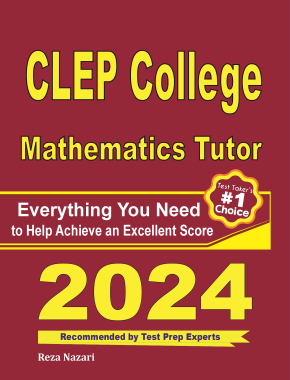
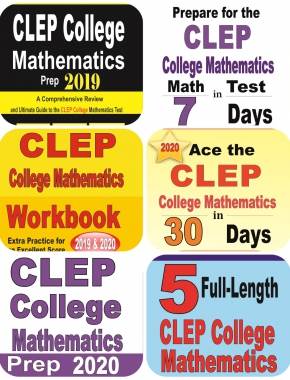
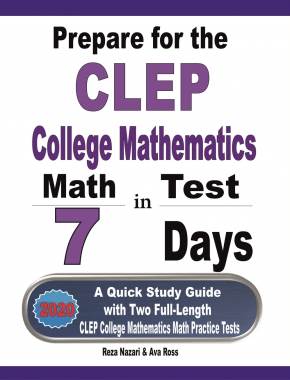
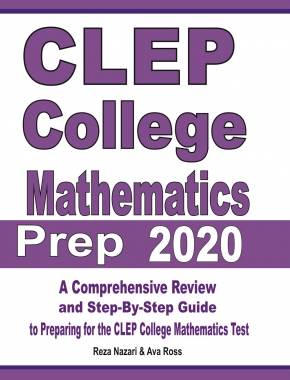
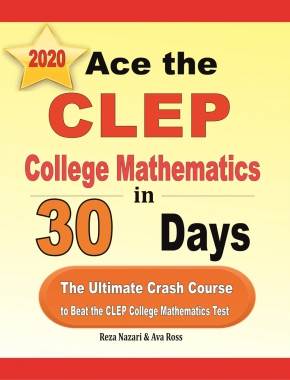
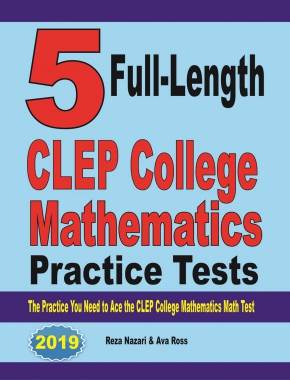
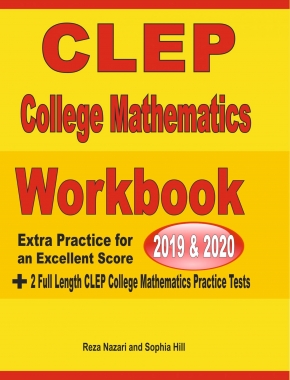

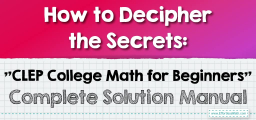
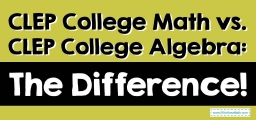

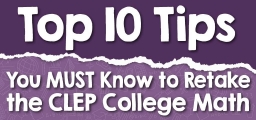


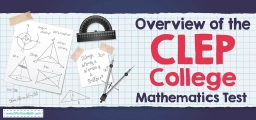
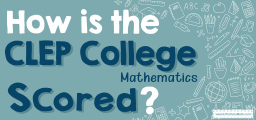


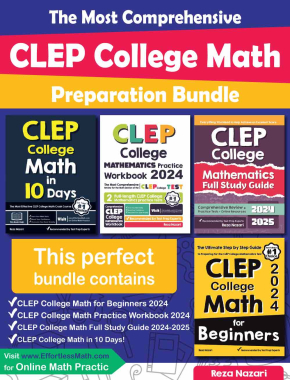
What people say about "FREE CLEP College Math Practice Test - Effortless Math: We Help Students Learn to LOVE Mathematics"?
No one replied yet.